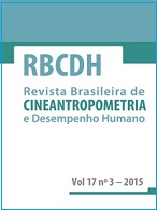Rate of force development and torque production assessment in spastic stroke survivors
DOI:
https://doi.org/10.1590/1980-0037.2015v17n3p328Abstract
The aim of this study was to compare the rate of force development (RFD) and maximum torque in spastic stroke survivors and healthy individuals. Fifteen stroke survivors (57.3 ± 11.2 years) with ankle spasticity and fifteen healthy individuals (59.3 ± 6.4 years) participated in this study. An isokinetic dynamometer was used to maximum voluntary isometric contraction (MVC) and RFD assessment of plantar flexors muscles of ankle, which the individuals were instructed to produce maximum torque as fast as possible. The absolute RFD was normalized by MVC (relative RFD). In results were observed significant differences in RFD of affected limb (43.3 ± 8.5 Nm/s) and unaffected limb (98.9 ± 20.4 Nm/s) compared to healthy (186.2 ± 25.2 Nm/s), but with no differences between affected and unaffected limbs (p=0.15). In relation to relative RFD, the affected limb (9.76 ± 1.1 %MVC/s) was significant different than healthy (13.08 ± 1.5 %MVC/s). The MVC produced by affected limb (46.55 ± 7.98 Nm) was significant lower than unaffected limb (84.29 ± 8.47 Nm) and, the two limbs of stroke survivors were weakness than healthy individuals (128.02 ± 9.36 Nm). Lastly, the spasticity level present higher negative correlation in relation to RFD (R= -0.725; p= 0.002) and MVC (R= -0.717; p=0.003). The spasticity promotes alterations in capacity to produce maximum force and fast force in affected and unaffected limbs of stroke survivors compared to healthy.



